10 Scenes From EMC World 2009

From solution provider meetings and exhibits and presentations to news announcements with some of the biggest names in the IT industry, EMC did a lot to highlight the importance it places on partnering at its EMC World conference.
EMC used its conference, held in Orlando, Fla., late last month, to not only introduce new storage products, but to introduce cloud computing plans and partnerships and to tell its end-user attendees about the importance of partnering.
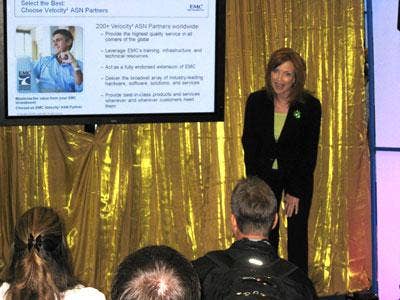
EMC World held sessions aimed specifically at teaching customers the benefits of working with its Velocity ASN program for solution providers.
Susan Mathein, a professional presenter working with Live Marketing, a Chicago-based provider of marketing services, was at the EMC Global Services booth telling customers the advantages of working with EMC's Velocity ASN members.
Among them was the fact that EMC's partners offer the same solutions that customers can source from EMC, and that they have the full support of the vendor.
After her presentation, Mathein asked the attendees questions about her presentation, and passed out prizes for the correct answers.
One of the harder questions was, What does ASN stand for?
(Here's a hint, fill in the blanks: __uthorized __ervices __etwork.)

EMC used a big portion of its EMC World conference to discuss the importance of cloud computing, which is a way to dynamically combine and scale server, storage, networking and other resources inside and/or outside of a company's own traditional data center for such purposes as remote data storage or running Software-as-a-Service.
Keith Norbie, (left), director of the storage division of Nexus Information Systems, a Minnetonka, Minn.-based solution provider and EMC partner, called cloud computing a fantastic opportunity to liberate IT.
"No one raises a hand to say, 'I love this hardware,'" Norbie said. "Who raises their hand and says, 'I want to be glued to my desktop?' What clouds will deliver is greater availability and access to IT, and an always-on compute model."
Solution providers looking to build a cloud infrastructure can start with server and desktop virtualization, and then add other services. Nexus currently offers a suite of cloud-related services such as monitoring, backup, security and other emerging technologies, which lets it keep connected to customers.
"How is this 'cloud computing?'" Norbie said. "It gives us the ability to connect customers to Nexus with services that are always on and always protected."
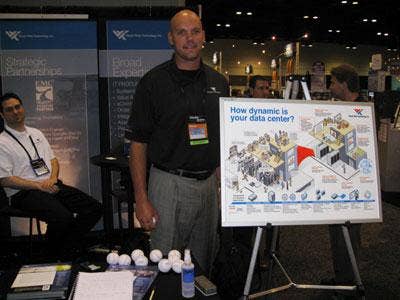
John Berrett, national technical architect at World Wide Technology, a St. Louis-based solution provider and EMC partner, gave presentations at EMC World on the topic of the data center of the future, drawing on its EMC, Cisco and VMware experience.
Berrett said that his company is already using its storage and virtualization skills to start providing cloud computing.
"Are we doing the total cloud? No," he said. "But customers are starting to build clouds."
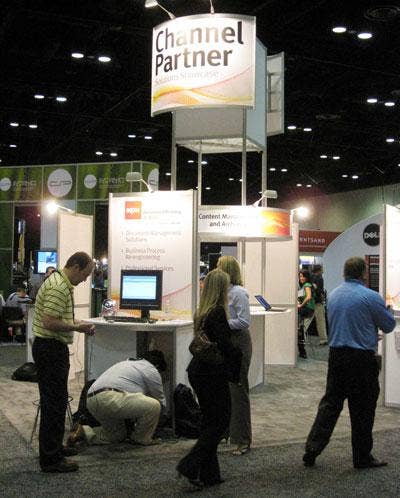
One of the booths at EMC World actually brought together four of the vendor's content management software partners: Business Imaging Systems (BIS), Oklahoma City; Portford Solutions Group, Ontario, Calif.; Ikon Office Solutions, Malvern, Pa.; and Image Access, Hackensack, N.J.
Mark Lewis, president of EMC's Content Management & Archiving division, said that his organization handles between 600 and 700 different software SKUs, including a handful of what he considers to be channel products.
These include the ApplicationXtender suite of document capture, imaging and delivery software, which Lewis said is a channel-only line; the Captiva line of document capture software, and the new SourceOne line of e-discovery and e-mail management software, which are heavily focused on the channel; and the Document Sciences software for developing and handling insurance company forms, which is just starting to be available to the channel.
EMC is also looking to increase its business through the channel with such products as its e-mail archiving and eDiscovery products, and is currently certifying channel partners through its Velocity program, Lewis said.
The insurance and financial software markets are actually very strong, and there are plenty of deals out there for partners who can talk about the ROI, or return on investment, Lewis said.
However, he said, customers are not as likely to be looking at big infrastructure projects. "It's now on a project-by-project, a solution-by-solution, basis," he said.
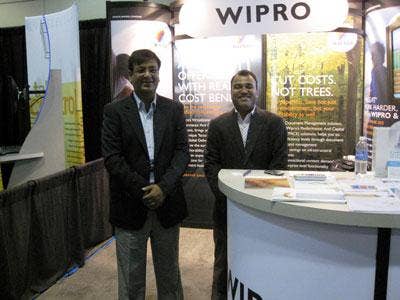
Among the exhibitors were other solution providers, including CDW of Vernon Hills, Ill.; Arrow ECS of Alpharetta, Ga.; and Wipro Technologies, an Oakbrook Terrace, Ill.-based division of India-based Wipro Ltd.
Atul Sood (left), practice head for transformation consulting and system integration, and Rohit Yogendra Khanna (right), practice manager, manned their company's booth to try and reach out to the 7,000 or so attendees at the conference.
About 60 percent of Wipro's business now comes from North America, Sood said.
Wipro is also showing specific programs to help customers survive in these tough economic times, including its latest program, PACE, or Performance And Capital Efficiency, Sood said.
The PACE program focuses on using Wipro's consulting, application development and maintenance, infrastructure, data center and business process capabilities to help customers in four main areas: IT savings, IT transformation, IT rationalization and post-merger integration.
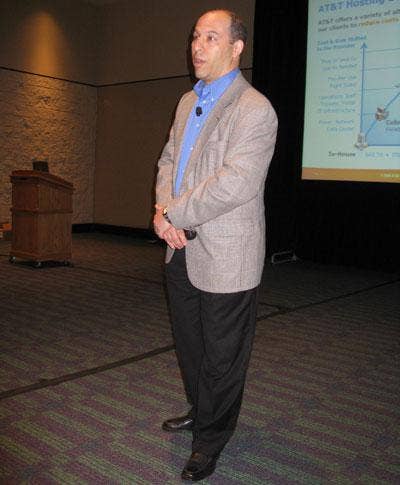
EMC used the conference to unveil its Atmos onLine cloud storage service and introduce AT&T and eBay as its first partners for services based on its Atmos technology.
EMC's Atmos onLine service is a highly scalable online storage infrastructure that makes it possible for a service provider to offer cloud-based storage that is scalable to Petabytes of capacity and can be stretched over multiple sites scattered around the world.
AT&T is using the technology behind Atmos to power its Synaptic Storage-as-a-Service, enterprise-class on-demand storage offering, said Steve Caniano (left), vice president of hosting and application services at AT&T.
Caniano said there is a real demand for RAID-level protection on the cloud, and AT&T is working with EMC to develop scalable storage and protection on a worldwide basis. Synaptic Storage-as-a-Service already has launched two of AT&T's Internet data centers worldwide and will eventually go global, Caniano said.
EMC also unveiled its EMC Velocity Atmos Partner Program under which it is providing APIs to ISVs to create applications leveraging both its Atmos and its Atmos onLine offerings.
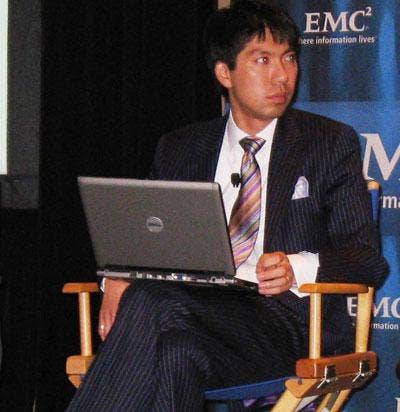
It takes more than an iridescent tie to make Benjamin Woo, vice president of enterprise storage system research at IDC, stand out on a panel of analysts.
Woo also happens to be a former solution provider. Prior to joining IDC last year, he was vice president of sales and marketing at ASI System Integration, a New York-based solution provider.
Woo said that technology such as EMC's Atmos onLine cloud storage provides APIs that allow solution providers to help customers share data based on their policies, and is especially applicable to multinational companies.
The early adoption of the Atmos technology by AT&T should help other solution providers find ways to help customers adopt data center-class online storage, Woo said.
"AT&T is a good partner in the U.S., Canada and overseas," Woo said. "Other solution providers will look at this and say, 'There may be something there for me.' Once they can help drive applications on a worldwide basis, they will see growth from their customers."
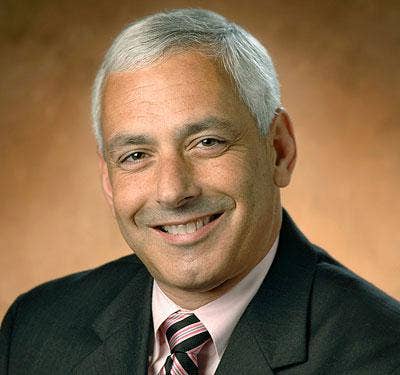
Pete Koliopoulos, vice president of global channel marketing at EMC, said his company's channel partners are ready to start working with cloud computing.
The vast majority of EMC's solution providers also work with VMware, 80 percent of its VARs are Cisco partners, and the vast majority also work with RSA Security technology, Koliopoulos said.
Those partnerships mean that solution providers already have the foundation on which to build a cloud computing practice, he said.
"We'll be adjusting our channel program to align with the cloud more, and are already doing the blueprint for solutions such as Exchange and disaster recovery," he said. "The last six to nine months we've been seeing deals getting started. Fewer big deals, more smaller deals. When you look at what it takes to get to the cloud, partners are doing it today."
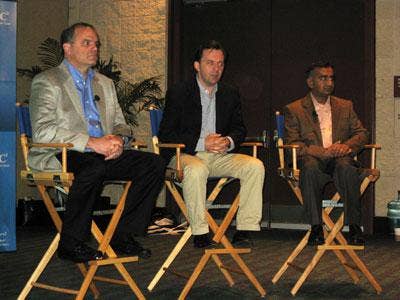
Getting into cloud computing requires a little help from your friends.
Chuck Hollis (left), EMC's vice president and CTO of global marketing, said that cloud computing is still in its early stages, and its definition is a moving target.
"My joke is, we should call it 'fog computing,'" Hollis said.
Even so, interest in public clouds like those built by Amazon and Google show there is a customer need, and EMC and its partners are responding with dynamic and scalable storage, information management, resource management and security, Hollis said.
"I'd like to go on record and say, this will be the dominant trend in IT," he said.
Ed Bugnion (center), Cisco CTO, said that virtualization, networking and scalability are the three pillars to cloud computing.
Cisco has invested heavily in the networking and scalability pillars with such technologies as virtual and physical networking switches for VMware environments and its Unified Computing System (UCS) architecture, which combines server, storage and networking into a single system.
Parag Patal, VMware's vice president of alliances, said that cloud computing requires multivendor interoperability in order to balance workloads between numerous external clouds and customers' internal IT infrastructures, which is why it is important for the industry to work together on the technology.
"There's enough standards and protocols in place for people to jump into [cloud computing]," Patal said. "I think the timing is right."